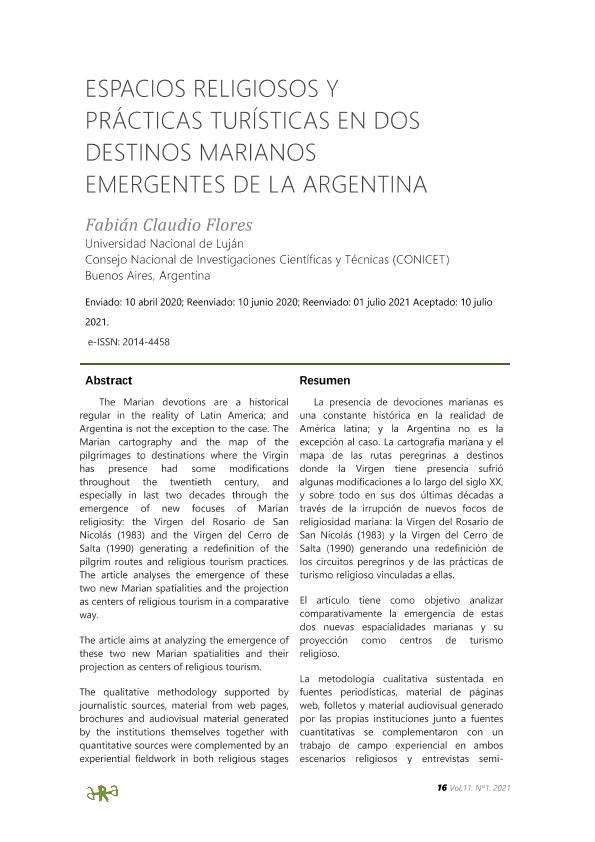Artículo
La presencia de devociones marianas es una constante histórica en la realidad de América latina; y la Argentina no es la excepción al caso. La cartografía mariana y el mapa de las rutas peregrinas a destinos donde la Virgen tiene presencia sufrió algunas modificaciones a lo largo del siglo XX, y sobre todo en sus dos últimas décadas a través de la irrupción de nuevos focos de religiosidad mariana: la Virgen del Rosario de San Nicolás (1983) y la Virgen del Cerro de Salta (1990) generando una redefinición de los circuitos peregrinos y de las prácticas de turismo religioso vinculadas a ellas.El artículo tiene como objetivo analizar comparativamente la emergencia de estas dos nuevas espacialidades marianas y su proyección como centros de turismo religioso.La metodología cualitativa sustentada en fuentes periodísticas, material de páginas web, folletos y material audiovisual generado por las propias instituciones junto a fuentes cuantitativas se complementaron con un trabajo de campo experiencial en ambos escenarios religiosos y entrevistas semi-estructuradas a distintos sujetos. El estudio comparativo permitió advertir las singularidades de dos casos emergentes con diferentes niveles de avance, mostrando que estas formas contemporáneas dan cuenta de una complejidad que demanda evaluar sus resultados constantemente. The Marian devotions are a historical regular in the reality of Latin America; and Argentina is not the exception to the case. The Marian cartography and the map of the pilgrimages to destinations where the Virgin has presence had some modifications throughout the twentieth century, and especially in last two decades through the emergence of new focuses of Marian religiosity: the Virgen del Rosario de San Nicolás (1983) and the Virgen del Cerro de Salta (1990) generating a redefinition of the pilgrim routes and religious tourism practices. The article analyses the emergence of these two new Marian spatialities and the projection as centers of religious tourism in a comparative way. The article aims at analyzing the emergence of these two new Marian spatialities and their projection as centers of religious tourism. The qualitative methodology supported by journalistic sources, material from web pages, brochures and audiovisual material generated by the institutions themselves together with quantitative sources were complemented by an experiential fieldwork in both religious stages and semi-structured interviews with different subjects. The comparative study allowed us to notice the singularities of two emergent cases with different levels of advance, showing that these contemporary forms account for a complexity that requires constant evaluation of their results.
Espacios religiosos y prácticas turísticas en dos destinos marianos emergentes de la Argentina
Fecha de publicación:
08/2021
Editorial:
Universidad de Barcelona
Revista:
Ara
e-ISSN:
2014-4458
Idioma:
Español
Tipo de recurso:
Artículo publicado
Clasificación temática:
Resumen
Palabras clave:
TURISMO RELIGIOSO
,
MARIOFANÍA
,
PEREGRINACIONES
Archivos asociados
Licencia
Identificadores
Colecciones
Articulos(SEDE CENTRAL)
Articulos de SEDE CENTRAL
Articulos de SEDE CENTRAL
Citación
Flores, Fabian Claudio; Espacios religiosos y prácticas turísticas en dos destinos marianos emergentes de la Argentina; Universidad de Barcelona; Ara; 11; 1; 8-2021; 16-36
Compartir




